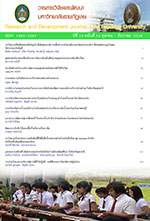พัฒนาการบันทึกโน้ตลายพื้นบ้านอีสานเป็นทางขิม
Keywords:
พัฒนา, บันทึกโน้ต, ลายพื้นบ้านอีสาน, ทางขิม, development, notes, northeastern folk music, khimAbstract
Abstract in Thai unavailableA Development of Northeastern Folk Music Notation for Khim
The objectives of the research on "A Development of Northeastern Folk Music Notaion for Khima" were: 1) to develop the northeastern folk music notation for Khim (hammered dulcimer), and 2) to apply the northeastern folk music notation for the performance of Khim. The sample consisted of 10 melodies of northeastern folk music: Laai Toey Khong, Laai Toey Bhama, Laai PhuThai Law Toob, Laai Lum Serng Pong Lang, Laai Pong Lang, Laai Nok Sai Bin Khaamtoong, Laai Serng Bung Fai, Laai Nam Toan Tard, Laai Maleang Phu Tom Dok Mai, and Laai Bai Si Su Khuan. A Thai musical instrument, Khim with 7 bridges was applied for the development of the northeastern folk notes. Thai music system, solfege system (or "sol-fa syllable"), and the sound of Khlui Phiang Aw were used as the references to identify the sounds of music for the note development. 3-line staff with 8 spaces was designed to represent the 3 levels of the sounds produced by the Khim with 3 rows of 7 bridges. The scale of the northeastern folk music corresponding to a minor Pentatonic was used in this study. 25 Music-major students of Humanities and Social Sciences Faculty, Loei Rajabhat University were assigned to perform the Khim by using the developed notes. The findings indicated that the music notes developed based on the northeastern folk music melodies for the practice of Khim were perfectly performed both by individual and in group. The notes were applicable to Phin, Saw Duang, Saw U, and Pi Mon.
The development of the northeastern folk music notation for Khim was a musical innovation for the benefit of society. This combination between Thai classical music and folk music was the transmission of the national music cultures from the past to the present which helped keeping the music cultures up-to-date and served the principle of music culture transmission in creating new things with derivation and application of the existing cultures in order to be well-known in public. Loei Rajabhat University has its major responsibility in conserving Thai arts and cultures. Music Program as a part of the university has a special assignment from the university to maintain and treasure the musical cultures by doing researches for musical innovation to serve the society.
Downloads
How to Cite
Issue
Section
License
ข้อความที่ปรากฎในวารสารฉบับนี้เป็นความคิดเห็นของผู้เขียนแต่ละท่าน สถาบันวิจัยและพัฒนา มหาวิทยาลัยราชภัฏเลย และกองบรรณาธิการ ไม่จำเป็นต้องเห็นด้วยและไม่มีส่วนรับผิดชอบใดๆ
สถาบันวิจัยและพัฒนา มหาวิทยาลัยราชภัฏเลย ขอให้ผู้อ่านอ้างอิงในกรณีที่ท่านคัดลอกเนื้อหาบทความในวารสารฉบับนี้






